Researchers hypothesize that blobs in post-Big Bang fields of energy, known as Q-balls, could explain how matter came to dominate over antimatter in our Universe, and they plan to use gravitational waves to find their evidence. Plus, a crewed launch to the ISS features Japanese tourists, NASA selects the latest astronaut class, and What’s Up is the Geminids.
Podcast
Show Notes
Big stars home to giant planet
- MPIA press release
- “A wide-orbit giant planet in the high-mass b Centauri binary system,” Markus Janson et al., 2021 December 8, Nature
Massive jet has delicate structure
- NRAO press release
- “Reading M87’s DNA: A Double Helix Revealing a Large-scale Helical Magnetic Field,” Alice Pasetto et al., 2021 December 7, The Astrophysical Journal Letters
Nebula shines asymmetrically
- NOIRLab press release
Soyuz MS-20 sends 3 to ISS, including Japanese tourists
NASA names 10 to latest astronaut class
- NASA press release
Q-balls knock matter into dominance
- Kavli IPMU press release
- “Detectable Gravitational Wave Signals from Affleck-Dine Baryogenesis,” Graham White, Lauren Pearce, Daniel Vagie, and Alexander Kusenko, 2021 October 27, Physical Review Letters
What’s Up: Geminid meteor shower peak December 14
- Geminid meteor shower 2021 peaks December 13-14 (EarthSky)
- 3200 Phaethon (NASA JPL)
Transcript
Hello and welcome to the Daily Space. I am your host Dr. Pamela Gay.
And I am your host Beth Johnson.
And we are here to put science in your brain.
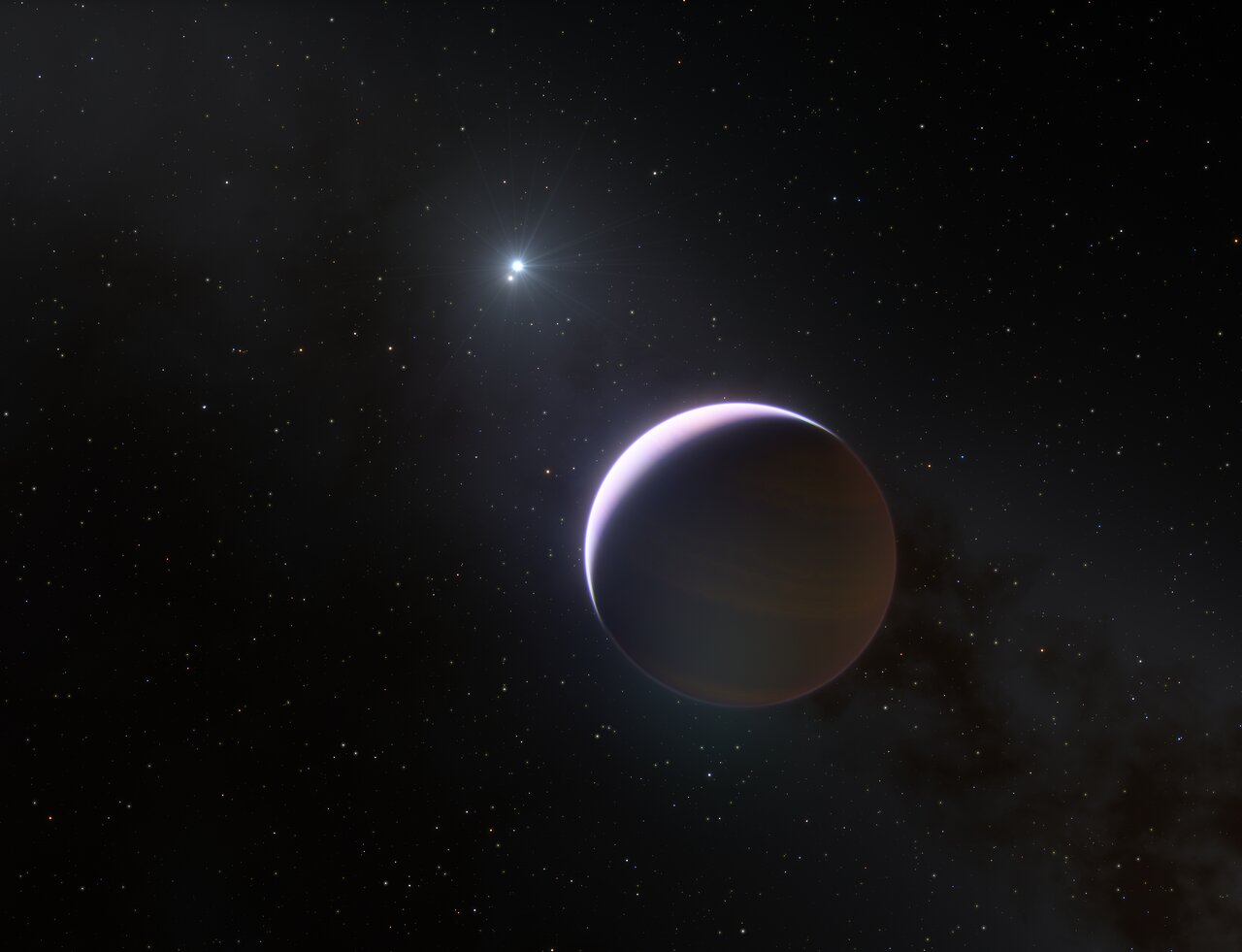
To start today’s episode, we bring you the Universe’s latest example of a star system we didn’t think should have a planet most definitely having a planet. The European Southern Observatory’s Very Large Telescope has imaged a planet orbiting a binary star system. The two stars have a combined mass greater than six times the mass of our Sun, and the planet is a massive ten times the mass of Jupiter.
This large world orbits at a very large distance: it is a hundred times further from its stars than Jupiter is from our Sun. In our solar system, this would put the planet out in the middle of the Kuiper Belt.
We are able to see this planet reasonably easily because the central stars are giving off so much light that the planet can then reflect back to us, and it’s those stars that make it so confusing to find a planet. When this system was young, those two stars were blasting their surroundings with amazing stellar winds and radiation, and it had been thought that protoplanets would get disrupted before they had a chance to grow. But it turns out that planets gonna form where planets gonna form, and that appears to be absolutely everywhere.
With larger and larger telescopes coming online in the next few years, it should become possible to start to make out features of this wide separated planet and learn more about what it means to be a planet in a system where the stars are so overpowering.
One of the basic rules of the universe is: big things have the potential to do highly energetic things. Those big stars had the potential to be the destroyers of worlds; they just happen to let at least that one planet survive.
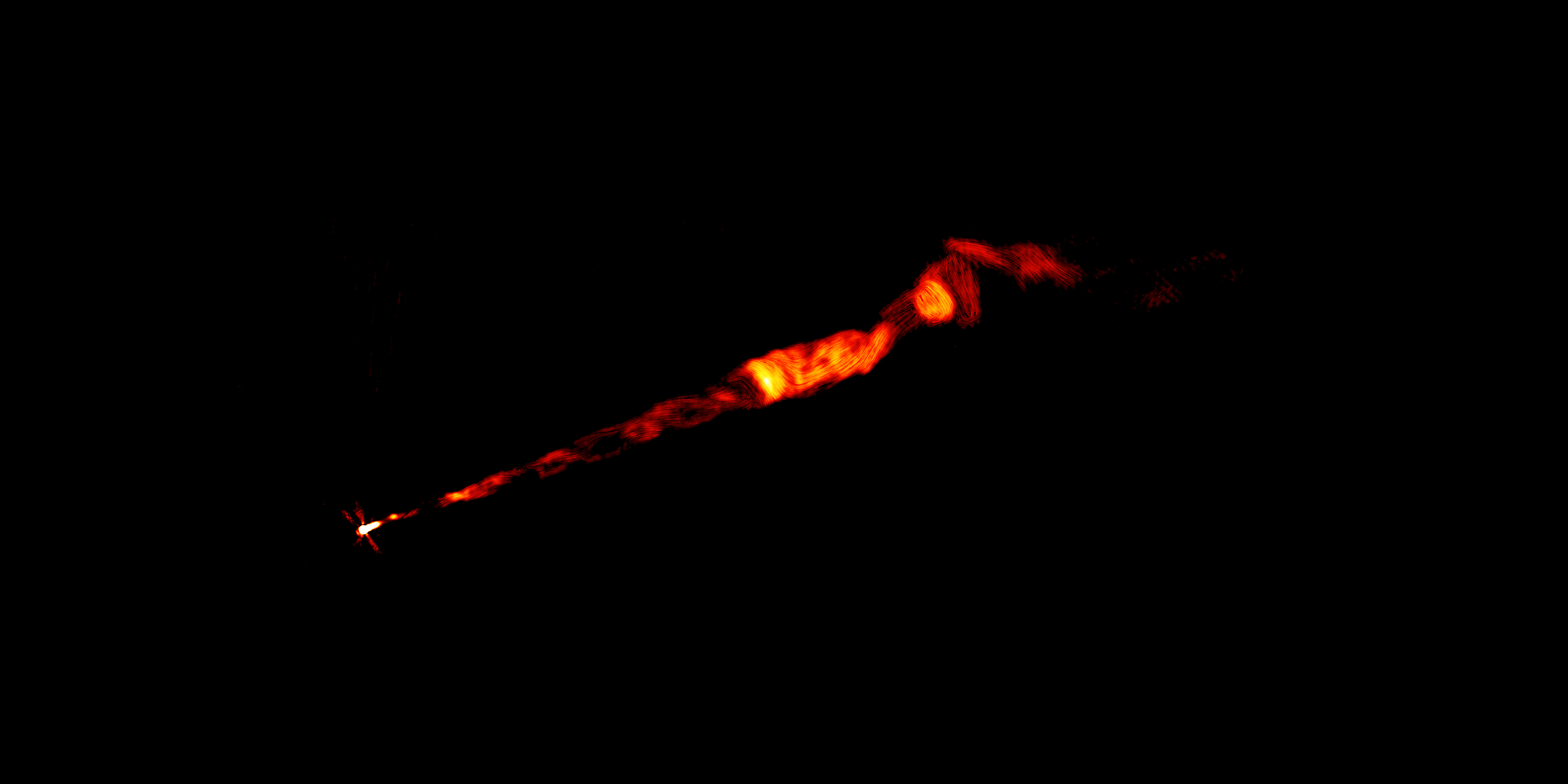
Those stars have nothing on the power of galaxies. Fifty-five million light-years away, the galaxy M87 hosts a massive black hole that is actively eating infalling gas and dust. As this material spirals in, it generates a massive magnetic field, and that magnetic field acts a bit like a rail gun and fires particles out in a 3,300 light-year long jet.
In new images from the Very Large Array, astronomers have examined the structure of that jet and discovered that it has a delicate double helix structure. These findings are published in The Astrophysical Journal Letters with lead author Alice Pasetto. According to co-author Jose Marti: Helical magnetic fields are expected close to the black hole and are thought to play a highly important role in channeling the material into a narrow jet, but we didn’t expect to find such a strong helical field extending so far outward.
According to an NRAO press release on this study: …scientists suggested that instabilities in the flow of material within the jet could make the magnetic field more ordered at the distances seen in the new VLA images. The instabilities produce regions of higher pressure which also compress the magnetic field lines.
These instabilities in turn are thought to produce the distant double helix structure.
This research shows again that we think too small. The Universe once again builds things on a grander scale than we expect.

The scale of things in our universe is really something outside our ability as humans to understand, and across all those different scales, physics works the same. Just as infalling material around a black hole can power massive jets, infalling material around a forming star can also form jets – smaller, less exciting jets – but jets all the same.
In a new image from the Gemini South telescope, astronomers have captured the asymmetric jets of a forming star. A dark band can be seen blocking light from where the star is believed to be. The band is thought to be the disk where planets could form in the future. According to the NOIRLab press release, this system looks like a one-winged butterfly. This glowing system is part of a larger star-forming region and is surrounded by gas that is reflecting light, casting an eerie glow on the entire scene.
On December 8 at 07:38 UTC, a Russian Soyuz 2.1a launched the Soyuz MS-20 spacecraft into orbit from site 31-6 at the Baikonur Cosmodrome in Kazakhstan. Onboard were cosmonaut Alexander Misurkin and two paying passengers: Japanese billionaire Yusaku Maezawa and his assistant Yozo Hirano.
After a nine-minute flight into orbit, the Soyuz spacecraft separated from the third stage of its rocket and deployed its solar panels and antennas to begin its quick four-orbit rendezvous with the International Space Station (ISS). The Soyuz typically does a two-orbit rendezvous, but that requires the ISS to do some orbital maneuvers, which likely would have “required an undesirable decrease in the ISS’ … altitude”. The Soyuz docked to the Poisk docking module at 13:38 UTC, and after the usual leak checks, the crew was welcomed aboard.
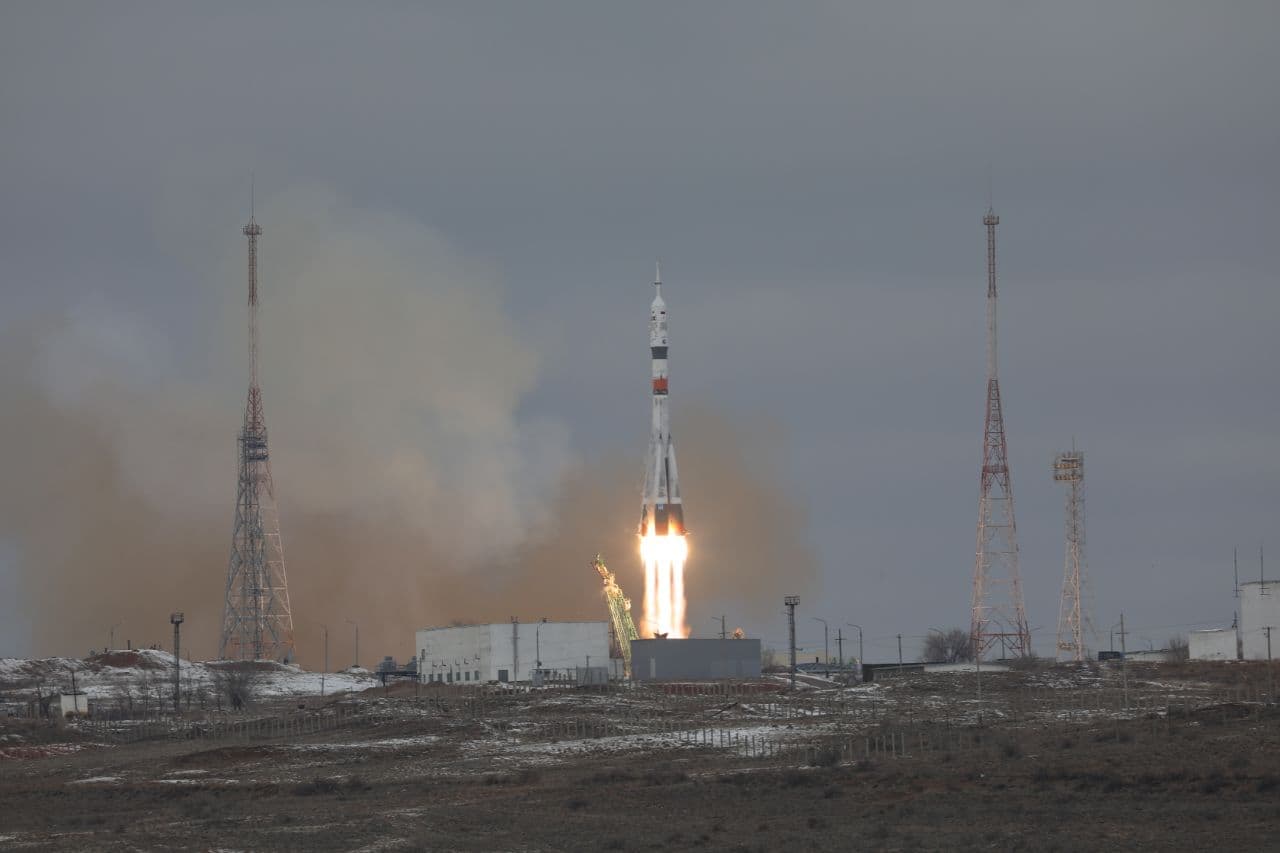
Yusaku and Hirano’s flight is the third commercial flight to the ISS in the past decade or so and the second this year, and they will be the second and third Japanese civilians to go to space. A new Soyuz is being used for the short twelve-day mission to allow Yusaku to gain some spaceflight experience prior to his flight around the Moon on a SpaceX Starship, which is currently scheduled for 2023 but may actually take place later than that. Like the previous tourist trips to the ISS, this one was organized by Space Adventures.
In addition to the people, the Soyuz delivered 162 kilograms of supplies to the ISS.
One interesting historical note about this flight is that the first Japanese citizen ever to go into space, journalist Toyohiro Akiyama, made a trip to Mir in December 1990 on Soyuz TM-11. He stayed there for eight days before returning to Earth and made the first news reports from space.
Speaking of astronauts, this past Monday, December 6, NASA announced the selection of ten new astronaut candidates out of over 12,000 applicants. According to NASA, they received applications from all 50 states, D.C, and a few U.S. Territories including Puerto Rico, Guam, the Virgin Islands, and the Northern Mariana Islands.
One major change in the selection process for this year was the requirement for all applicants to have a master’s degree in a STEM field. Another change was because the selection process took place during the ongoing pandemic: NASA used an online assessment tool for the first time.

The ten candidates will begin two years of astronaut training at the Johnson Space Center in Houston, Texas, next month.
These astronauts will be among those chosen to take part in the Artemis program’s return to the Moon for a landing, whenever that happens. They could also be assigned to fly on one of the Commercial Crew spacecraft on an expedition to the ISS. There are six men and four women, and most of them have the usual military or test pilot background common of astronauts going back to the first group selected back in 1959.
One, Anil Menon previously worked at NASA as a flight surgeon on the ISS program and then was hired to perform the same role at SpaceX, ensuring their human spaceflight program started on the right foot. He was also a fighter pilot in the U.S. Air Force before becoming a flight surgeon.
Nicole Ayers led the first all-woman combat format of F-22 fighters.
Christina Birch has a Ph.D. in bioengineering and medaled three times in the World Cup as part of the U.S. national track cycling team.
Deniz Burnham also worked at NASA before being selected as an astronaut, interning at NASA’s Ames Research Center.
Andre Douglas also has a Ph.D. in systems engineering. Before being selected as a NASA astronaut, he worked at Johns Hopkins University Applied Physics Laboratory on, among other things, NASA’s DART mission.
Christopher Williams is a board-certified medical physicist with a Ph.D. in physics.
Marcos Berríos, Luke Delaney, Jack Hathaway, and Jessica Wittner all flew for various military services.
Congratulations to this latest class of NASA astronauts. We wish you well in your training and future missions.
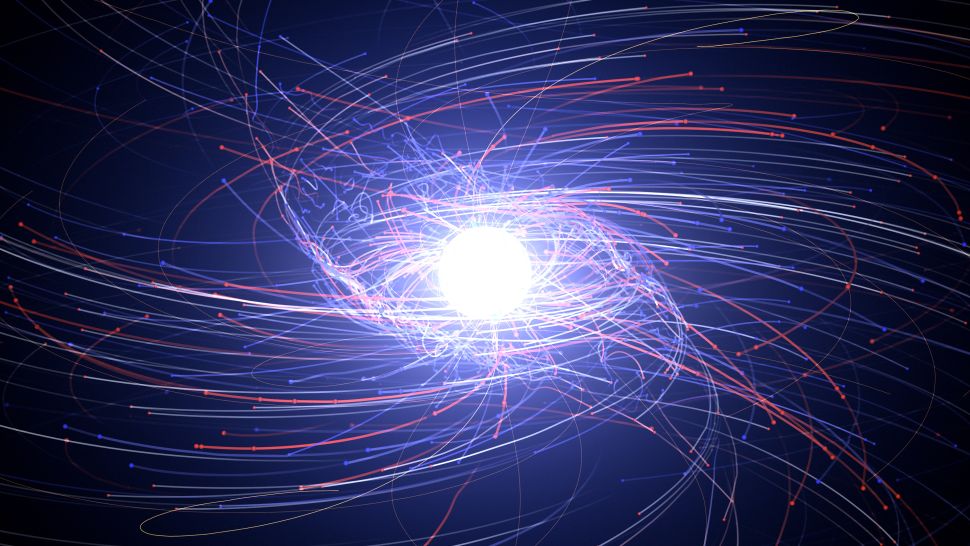
There are times as an astronomer that I look at a research paper, know it is a potentially important paper, and my brain just says, “no.” That is the case with the next story we’re going to cover, and I’m not going to lie — many, many cups of coffee went into trying to make sense of this science.
Normally we wouldn’t inflict a journal article on you, but just this once, I feel compelled to share the introductory sentences of a Physical Review Letters paper that really wanted to put me to sleep: The asymmetry between matter and anti-matter is a cornerstone puzzle of modern particle cosmology, as the Standard Model fails to provide an explanation. An elegant paradigm for explaining the asymmetry is the Affleck-Dine mechanism. Supersymmetric theories generically have flat directions, which have non-zero baryon or lepton number. During inflation, a scalar condensate generically develops in these directions, whose non-zero vacuum expectation value (VEV) spontaneously breaks C and CP. At the end of inflation, a baryon and/or lepton asymmetry is generated as the VEV coherently evolves and the condensate fragments. These resulting clumps may be long-lived nontopological solitons (Q-balls), carrying either lepton or baryon number [13].
Hidden in that scientific language is a remarkable piece of information: researchers may have figured out why our universe is dominated by matter. This work is led by Graham White.
Here is the background you need: when our universe first formed, everything was energy. As the Universe expanded and cooled, that energy was able to condense out as particles. Theorists don’t understand why those particles weren’t half matter and half antimatter, but observers and computational modelers find that to explain the Universe we have today, for every ten billion antimatter particles, there must have been ten billion and one matter particles. Why? That has been a point of confusion.
In this new research, the idea is put forward that during the brief epoch of inflation in the first minute of the Universe, a field was responsible for driving the Universe ever larger. This field, like other fields, has associated particles and energies, and as the period of inflation came to an end, those particles decayed in a way that left an excess of matter and bundles of charged Q-balls. There is math to back the idea up, and it is math that requires a whole suite of new, supersymmetric particles to exist side by side with our known suite of particles.
We’ve been trying to find evidence of supersymmetry for a long time and have thus far totally failed, so the theory has a lot working against it.
While we can’t yet find supersymmetric particles, if they do exist, this paper lays out another possible way this paper can be proven: the team believes those Q-balls are temporary and when they decay, they would have enhanced the primordial gravitational waves that shaped our early universe. While we can’t peer into the pre-Cosmic Microwave Background universe because the microwave background is opaque, we can detect gravitational waves from that era. We don’t yet have the equipment to detect primordial gravitational waves, but maybe someday, and it is that maybe someday that makes this paper important; it offers a theory that is testable… eventually.
It also offers a really nice sleep aid; not all research is picturesque or can be written in exciting language. Still, even the science that wants to put me to sleep can be important to understanding our universe.
What’s Up
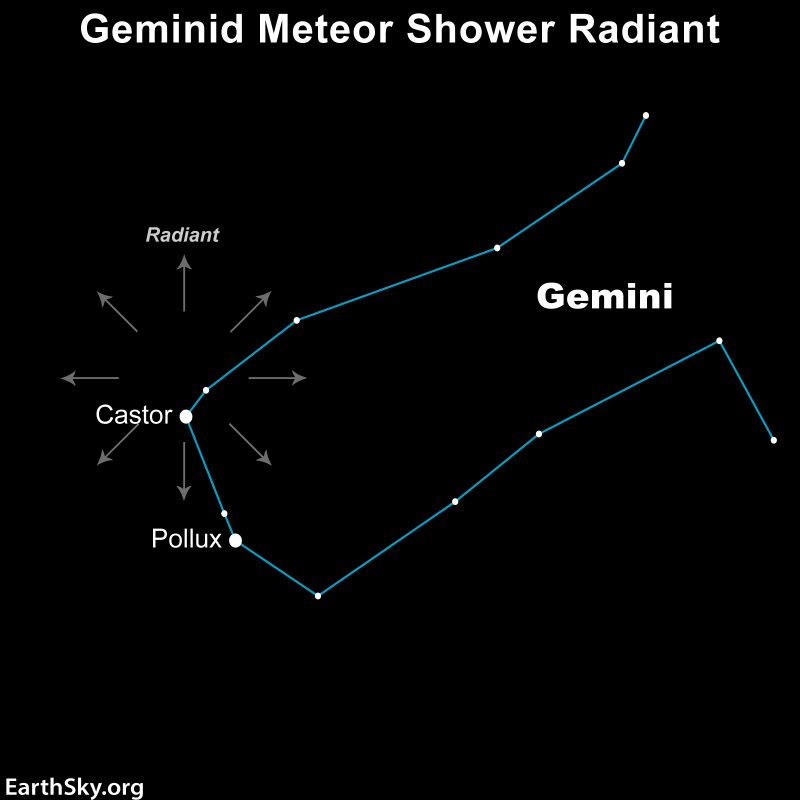
This week in What’s Up is another meteor shower, the Geminids. This meteor shower is known for being reliable compared to others. However, the time the meteors will be visible this year is limited by the Moon’s brightness.
The source of the Geminids, the radiant or the point on the sky the meteors come from, is easy to find. In the south-southwest is the brightest star in the sky, Sirius. Follow it well up to the pair of stars that are Castor and Pollux, two of the major stars in the constellation Gemini. The radiant for the Geminids is slightly west of the star Castor, the western star of the pair, as viewed during the morning of December 14 during the peak of the shower.
At 2 am on the 14th, no matter where you are on the planet, is the peak of the shower because that’s when the radiant is highest in the sky, but it’s visible starting the night of the 13th. Unfortunately so is the Moon, and it won’t set until 3 or 4 am. However, the Geminids are bright enough that you may see some of them even while the Moon is up. At a dark sky site, you can see as many as fifty meteors an hour, and in better years without a nearly full moon, you could see up to 150 meteors an hour.
The comet that provides the material for the Geminids is 3200 Phaethon, a “rock comet” otherwise known as an asteroid in a really eccentric orbit. In this case, 3200 Phaethon’s orbit goes from between the orbits of Mars and Jupiter all the way to seven times closer than Mercury’s orbit at 0.14 astronomical units. This is the closest any named asteroid gets to the Sun. It was the first asteroid to be discovered by spacecraft data after two scientists found it using images from the Infrared Astronomical Satellite. It was formally named 3200 Phaethon in 1985. It is a potentially hazardous asteroid because it does cross Earth’s orbit, but given that it has been continuously observed for 36 years, its orbit is well known. The closest it will get in the next 178 years is just inside the Moon’s orbit in December 2193.
Now our usual advice on how to see a meteor shower: with the unaided eye, the widest field of view you can get. Be sure to let your eyes get well adjusted to the dark; don’t use a planetarium app on your phone. Even if it has a red light function the brightness will impact your dark adaption. You can download a map from a link at our website and print it out to bring with you to the field. Use a proper red light flashlight to see the map when you’re out. You can get one from Amazon using our affiliate link so we can benefit as well. A reclining chair or hammock may also be helpful for remaining comfortable for hours of looking for meteors.
If you want to try to take pictures of this meteor shower, the best way to do that is to use an interchangeable lens camera with a wide-angle lens, at least 20mm, wider if possible. Erik likes the new Canon RF 16mm f/2.8 lens which he rented on his own a few months ago to try out. You can see a full review of that lens that Erik presented a few weeks ago at a link in our show notes for this episode. Note: We’re not sponsored by Canon (but we could be). Mount your camera on a tripod and take very long exposures using bulb mode and a remote shutter release cable (but not an app on your phone because you want to preserve your night vision), and you might capture a few meteors.
So remember, any night with a clear sky is always a good night to look up, but some nights might be better than others. Good luck hunting for meteors!
This has been the Daily Space.
You can find more information on all our stories, including images, at DailySpace.org. As always, we’re here thanks to the donations of people like you. If you like our content, please consider joining our Patreon at Patreon.com/CosmoQuestX.
Credits
Written by Pamela Gay, Beth Johnson, and Erik Madaus
Hosted by Pamela Gay and Beth Johnson
Audio and Video Editing by Ally Pelphrey
Content Editing by Beth Johnson
Intro and Outro music by Kevin MacLeod, https://incompetech.com/music/


 We record most shows live, on Twitch. Follow us today to get alerts when we go live.
We record most shows live, on Twitch. Follow us today to get alerts when we go live.